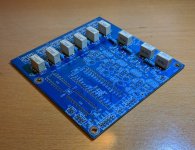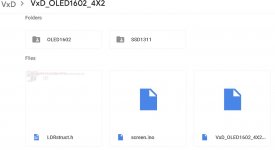I crimped them manually with flat pliersI've bought this crimping tool for crimping these pins from the original BOM.
The quality of the tool is fine but it is not useful for the purpose. It is around 5mm thick so it squeezes both sets of "arms" at the same time. Besides that the whole pin seems to get twisted.
How can I crimp a cable to those pins? I tried manually with a flat pliers, which seemed to be a PITA.
Thanks! Bugger!
I wonder if it is easier to solder the cables on the front "arms", and only squeeze the back arms that goes on the plastic.
I have some jumper cable like this, but its only 26AWG which I am not comfortable with (?). Those are really easy to use, and also 2.54mm spacing.
I wonder if it is easier to solder the cables on the front "arms", and only squeeze the back arms that goes on the plastic.
I have some jumper cable like this, but its only 26AWG which I am not comfortable with (?). Those are really easy to use, and also 2.54mm spacing.
I crimped them manually with flat pliers
Thanks, will try that when I have the timeI always solder them
This OLED display has exact dimensions of LCD1602, so it means it will fit right in the aliexpress F6 chassis:
1602 OLED Display [Multi-interface support] SPI/8080/I2C - White Color | eBay
And it works with OLED1602 firmware. Just tested it.
1602 OLED Display [Multi-interface support] SPI/8080/I2C - White Color | eBay
And it works with OLED1602 firmware. Just tested it.
This OLED display has exact dimensions of LCD1602, so it means it will fit right in the aliexpress F6 chassis:
1602 OLED Display [Multi-interface support] SPI/8080/I2C - White Color | eBay
And it works with OLED1602 firmware. Just tested it.
Newbie question here since I've never worked with any Arduino products or coding before.
In your list of files for the above eBay OLED display, I see 3 different files that end with the .ino suffix after clicking on the OLED1602 folder.
screen and VxD_OLED1602 as shown in the photo below and then there's a file called ExampleSketch listed.
Which file(s) should be used with eBay OLED display?
Attachments
Newbie question here since I've never worked with any Arduino products or coding before.
In your list of files for the above eBay OLED display, I see 3 different files that end with the .ino suffix after clicking on the OLED1602 folder.
screen and VxD_OLED1602 as shown in the photo below and then there's a file called ExampleSketch listed.
Which file(s) should be used with eBay OLED display?
Looks like several people have built this attenuator, yet nobody can tell me which files should be used with the 1.6.1 installer?
Neb, it would be informative if you could do a short YouTube video showing people every step to implementing the files in the link in your signature.
The files appear to be in zip(compressed) format. Extracting them is easy enough, but just what to do with them after that is anyone's guess I suppose unless your knowledgeable in Arduino products and coding, which I am not.
Also what isn't clear is getting the files from the installer downloaded to the Nano.
I'm sure there are many others out there like myself who don't know anything about Arduino products or coding.
New boards just arrived, better and more complete than everI have included new RCA footprints available widely from AliExpress, and also LDR test points. View attachment 682887
Hi ZDR,
How much for a single PCB shipped to Canada, Montreal?
Thanks
Do
Is it possible to buy with relays but not soldered on PCB?
They are all soldered I'm afraid, so the answer is no.
If one already has an Apple TV (4th Gen) would a second Apple TV remote work with this if it’s an earlier generation? Or would both wind up also inadvertently controlling the Apple TV?
Anyone else tried this remote with an Apple TV on same rack?
If I can’t do this, has anyone tried this?
Lutron Caseta Wireless Pico Remote for Audio, Works with Sonos, PJ2-3BRL-GWH-A02, White - - Amazon.com
Or have other ideas?
Anyone else tried this remote with an Apple TV on same rack?
If I can’t do this, has anyone tried this?
Lutron Caseta Wireless Pico Remote for Audio, Works with Sonos, PJ2-3BRL-GWH-A02, White - - Amazon.com
Or have other ideas?
- Home
- Source & Line
- Analog Line Level
- Arduino based LDR volume and source selection controller

